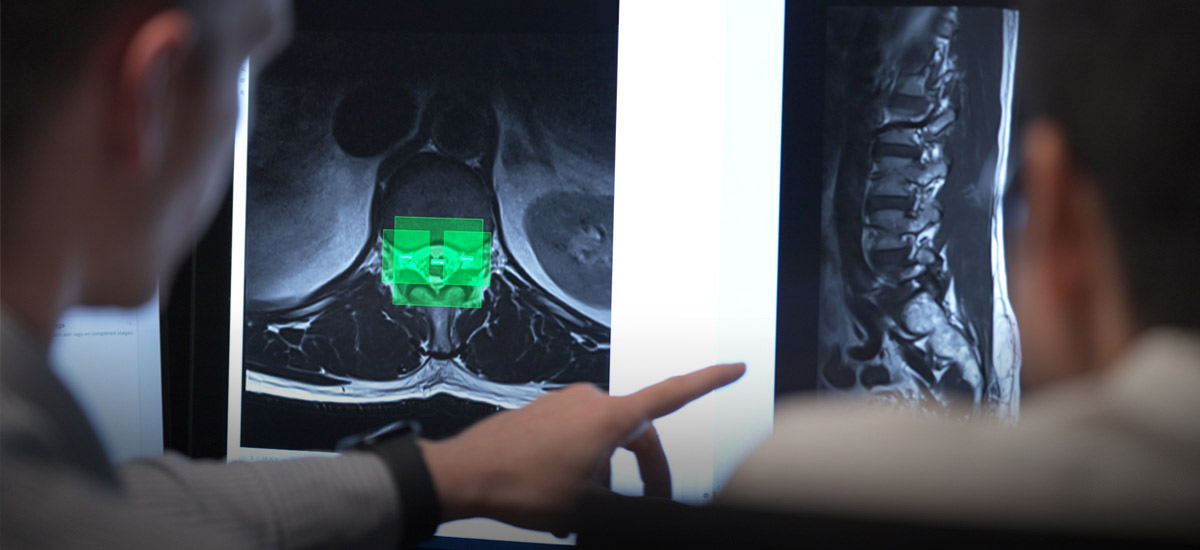Published on 17 January 2024
A programme called SpineAI can identify more serious underlying causes of lower back pain more accurately and efficiently.
If you feel pain in your lower back, you are not alone. According to Dr Jonathan Tan, Consultant, University Spine Centre, Department of Orthopaedic Surgery, National University Hospital (NUH), up to 80 per cent of the population will experience lower back pain at some point in their lives.
There are a multitude of causes for the problem, with the most common being strains or injuries to the ligaments and muscles of the back. Other common causes include slipped disc (prolapsed intervertebral disc) — which occurs when the soft inner core of a spinal disc pushes through a tear in the outer layer, causing pain and potential nerve compression in the spine — and degenerative causes due to ageing. Less-common causes of lower back pain include infection, inflammatory conditions, tumours or spinal trauma.

When does lower back pain indicate something more serious?
While pain in the lower back may go away over time, persistent pain could be a sign of something more serious.
“More serious causes of lower back pain that need to be detected and treated early include spinal tumours — with both primary spinal tumours and secondary metastases — spinal infections, spinal trauma and cauda equina syndrome,” said Dr Tan.
The lattermost ailment is a rare but serious condition where the nerve roots at the lower end of the spinal cord become compressed, leading to symptoms such as severe lower back and lower lumb pain, lower limb weakness, and loss of bowel or bladder control.
If left untreated, these conditions could, over time, lead to severe complications including persistent pain, paralysis and loss of bladder and bowel control. Early treatment can prevent the patient’s condition from deteriorating to this stage.
Thus, accurately diagnosing the cause of lower back pain is important so patients can promptly get appropriate treatment, especially if they have more serious underlying conditions. This is where Artificial Intelligence (AI) can play a part in providing more accurate diagnoses.
Minimising the risk of human error
Enter the National University Health System’s (NUHS)’ SpineAI programme, which can automatically and more precisely detect spine-related diseases based on magnetic resonance imaging (MRI) images.
Dr Tan, who started the programme with Dr Andrew Makmur, Consultant, Department of Diagnostic Imaging, NUH, explained that he usually orders an MRI scan for patients who do not respond to conservative treatment; have worsening weakness or numbness in the lower limbs; changes in bladder or bowel habits; or symptoms suggestive of conditions such as cancer, infections in the spine, trauma and inflammatory conditions.
When analysing these MRI images for spine-related diseases, Dr Makmur shared that SpineAI can help radiologists who work on a large volume of scans to identify abnormalities more efficiently. AI also helps automate tedious tasks such as measurements and labelling, which frees radiologists to focus on higher-value work.
“Patients benefit because they can get their diagnoses quicker,” said Dr Tan. “And if we are able to pick up something on the scan that needs urgent treatment, I’ll know about it sooner and can bring the patient back to get treated in a more timely fashion.”
Improving patients’ clinical outcomes
According to Dr Tan, spinal metastases are an important more serious cause of back pain in Singapore. These are tumours from other parts of the body — most commonly the lungs, breasts and prostate — which have spread to the spine. NUH has seen the number of surgically-treated spinal metastases patients double per year over the past 17 years. This may be attributed to advances in surgical and radiotherapy techniques, which have led to improved outcomes in patients with spinal metastases.
Dr Tan further noted that this has contributed to more than 80 per cent of spinal metastases patients improving or maintaining normal neurological function post-surgery. At the same time, cancer treatment methods have improved over the years, leading to higher chances of survival for patients.
With the implementation of the SpineAI programme, doctors can more efficiently decide on the appropriate course of treatment for such patients, such as whether they require surgery or radiotherapy.
Beyond that, AI is transforming the healthcare industry. Dr Makmur shared that from screening and monitoring for chronic diseases to improving cancer diagnosis and making sense of different types of data, AI has multiple benefits for use in healthcare. “With strong clinical research and ethical oversight, AI can make Singapore's healthcare more effective and sustainable while improving patient outcomes,” he said.
In consultation with Dr Andrew Makmur, Consultant, Department of Diagnostic Imaging, NUH; and Dr Jonathan Tan, Consultant, University Spine Centre, Department of Orthopaedic Surgery, NUH.




